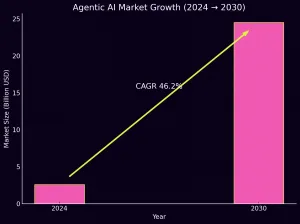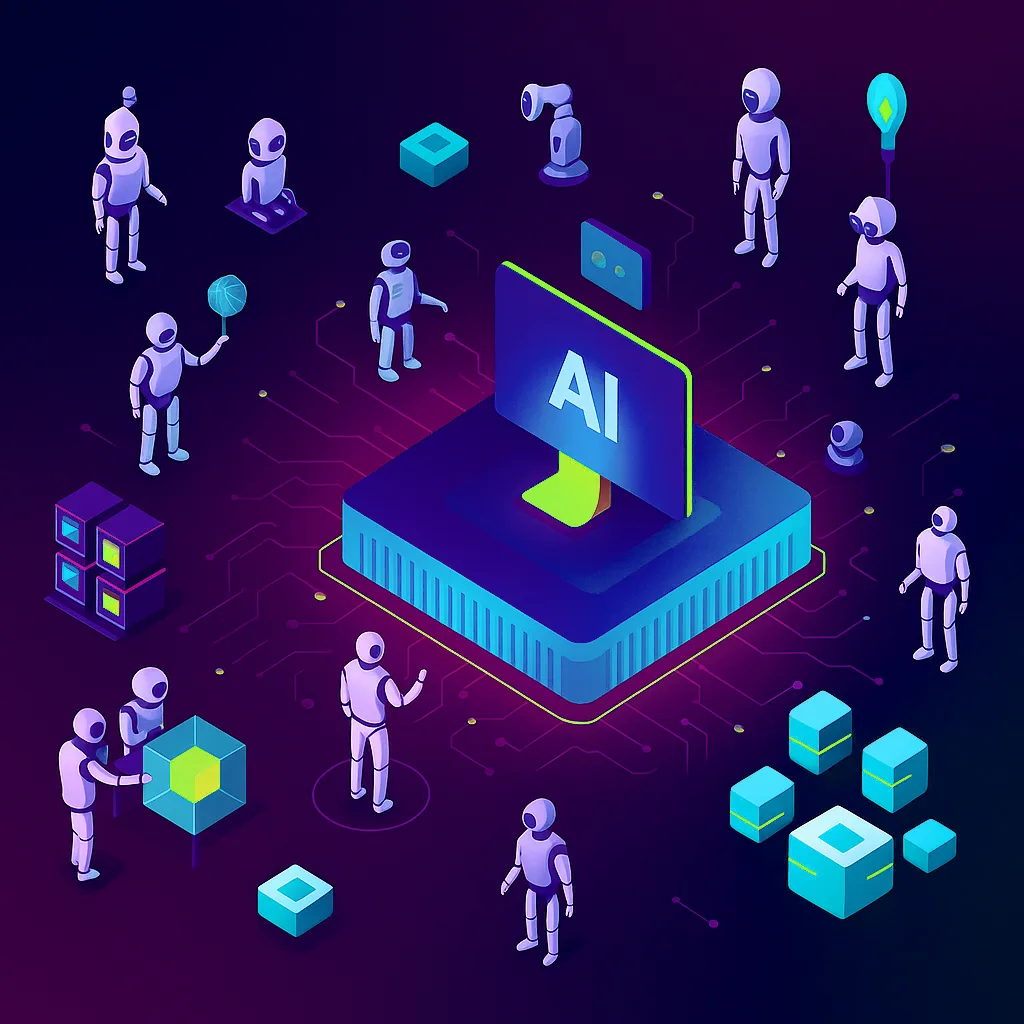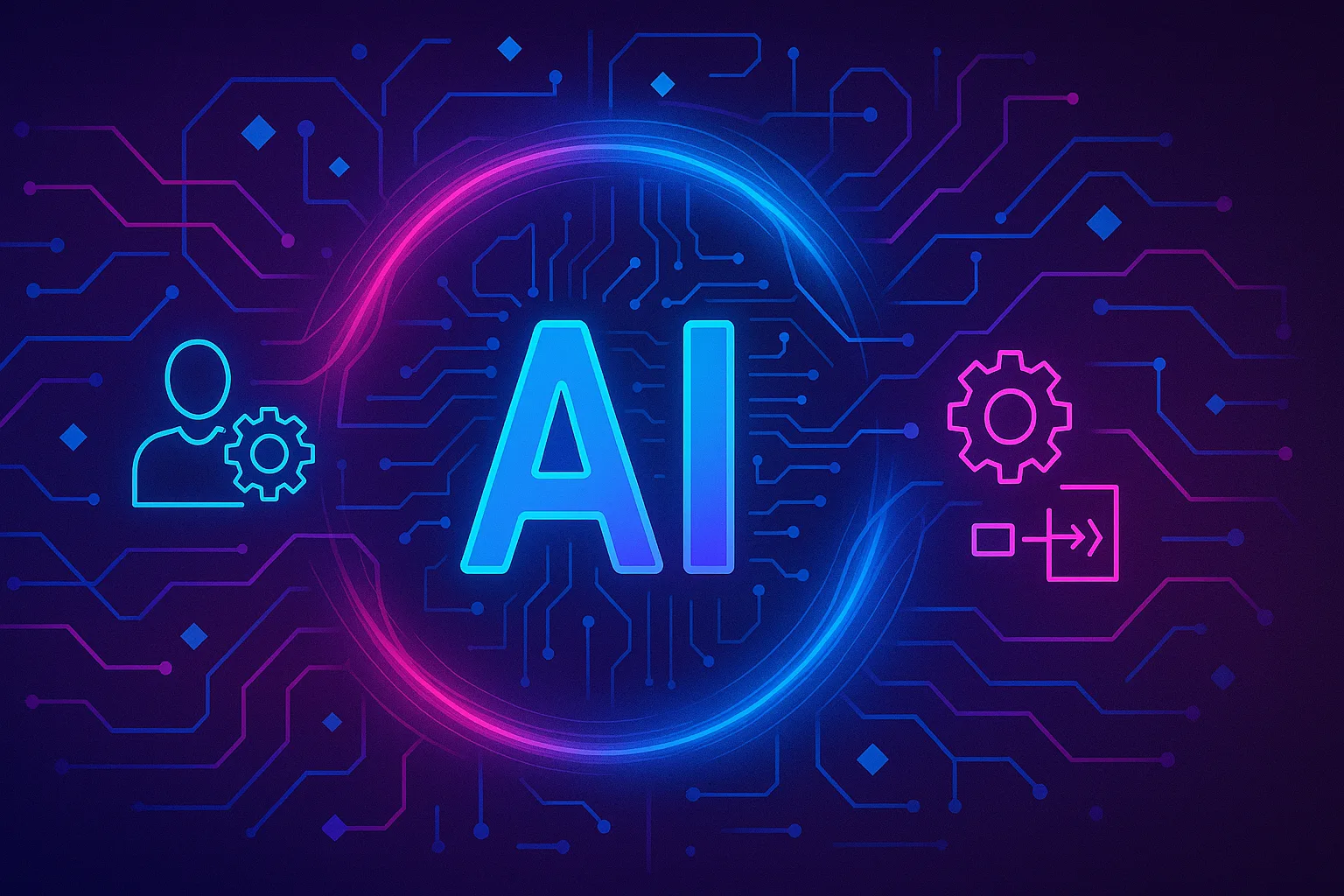TLDR:
- What is agentic AI? It refers to intelligent systems that can autonomously set goals, make decisions, and execute tasks without constant human input.
- It marks a significant shift from reactive chatbots to proactive, mission-oriented AI capable of dynamic interactions and learning.
- These systems blend the power of large language models (LLMs) with rule-based logic to deliver both flexibility and precision.
- The market for Agentic AI is projected to grow nearly 10x by 2030, presenting enormous potential across sectors like healthcare, defense, and industrial automation.
- Businesses adopting Agentic AI early will benefit from increased efficiency, scalability, and competitive advantage.
From Reactive Bots to Autonomous Agents
Artificial Intelligence (AI) has evolved rapidly over the past decade, but we are now on the brink of a transformative leap: the rise of Agentic AI. Unlike traditional systems that require explicit commands or rely on narrow prompts, Agentic AI introduces autonomy, agency, and contextual awareness into the mix. These systems can set goals, plan actions, and execute complex sequences of tasks without constant human oversight.
In this blog, we explore the fundamentals of Agentic AI, the explosive market opportunity it presents, and how companies like Geisel Software are uniquely positioned to shape this future.
What Is Agentic AI?
Agentic AI refers to a class of systems capable of making decisions, initiating actions, and completing tasks independently. These systems blend the adaptability of large language models (LLMs) with the precision of deterministic programming to create AI agents that can operate autonomously in dynamic environments.
The term “agentic” emphasizes the system’s ability to demonstrate “agency” to act independently in pursuit of a defined objective. This contrasts with earlier AI models that were reactive or reliant on human prompts. Agentic systems proactively manage workflows, access tools and resources, and continuously learn from their environment to improve over time (LinkedIn AI Insights, 2024).
A typical agentic AI platform might consist of:
- A central orchestrator (often an LLM)
- Multiple specialized agents (e.g., search tools, data parsers, action executors)
- A feedback loop for performance improvement
- This multi-agent architecture allows for greater scalability, maintainability, and adaptability across a variety of enterprise applications (Databricks, 2024).
How Agentic AI Evolved
Agentic AI has evolved from decades of research and technological progress. The journey began with early symbolic AI in the 1950s and 1960s, such as the Logic Theorist and General Problem Solver, which used rule-based logic to tackle structured problems.
The 1970s and 1980s saw the rise of expert systems-programs that encoded human expertise in rules but struggled with adaptability and learning.
The emergence of machine learning in the 1990s enabled systems to learn from data rather than rely solely on hand-crafted rules, paving the way for more adaptive and context-aware agents.
Recent advances in deep learning, reinforcement learning, and large language models have made it possible for agentic systems to learn, reason, and act autonomously in complex, real-world environments. (Agentic AI – Wikipedia)
Essential Skills for Building Custom Agentic AI Systems
Developing custom agentic AI systems requires a multidisciplinary skill set:
Programming Fundamentals
Proficiency in languages like Python, Java, or C++ is essential for building and integrating AI components.
Data Handling and Machine Learning
Skills in data collection, preprocessing, and applying machine learning algorithms are critical for training agents to recognize patterns and make informed decisions.
Natural Language Processing (NLP)
For agents that interact with humans or process text, expertise in NLP and transformer models (like GPT or BERT) is crucial.
Knowledge Representation and Reasoning
Understanding how to structure information and enable logical decision-making allows agents to operate autonomously and adapt to new scenarios.
Systems Integration and Deployment
Experience with APIs, cloud platforms, and containerization (e.g., Docker, Kubernetes) ensures that agentic systems can be deployed, scaled, and maintained efficiently.
Security and Privacy
Designing systems with robust security protocols and compliance in mind is increasingly important for enterprise applications.
Together, these skills enable teams to build agentic AI systems that are not only autonomous and intelligent but also robust, secure, and adaptable to the evolving needs of modern enterprises.
Market Trends and Growth Projections
 The enterprise Agentic AI market is not just a buzzword; it’s a booming sector. According to recent forecasts by Red Hat, the market is expected to grow from $2.59 billion in 2024 to $24.50 billion by 2030, translating to a staggering compound annual growth rate (CAGR) of 46.2%. This growth is fueled by the increasing complexity of business processes, demand for automation beyond chatbots, and the rise of edge computing and bespoke AI systems.
The enterprise Agentic AI market is not just a buzzword; it’s a booming sector. According to recent forecasts by Red Hat, the market is expected to grow from $2.59 billion in 2024 to $24.50 billion by 2030, translating to a staggering compound annual growth rate (CAGR) of 46.2%. This growth is fueled by the increasing complexity of business processes, demand for automation beyond chatbots, and the rise of edge computing and bespoke AI systems.
Several trends are driving this growth:
Business Complexity: Modern enterprises require AI systems that can handle nuanced, multi-step processes.
Automation Demands: There’s a growing need for AI that goes beyond chatbots and virtual assistants.
Edge Computing: The rise of IoT and real-time applications necessitates AI that can operate at the edge.
Build-Your-Own Solutions: Companies are shifting from off-the-shelf AI to bespoke systems tailored to their operations.
Real-World Applications and Use Cases
Agentic AI isn’t just a futuristic concept; it’s already reshaping how organizations operate, innovate, and serve their stakeholders. From streamlining internal workflows to revolutionizing customer interactions and driving breakthroughs in critical industries, agentic systems are proving their value in real-world applications every day. Here are just a few ways this technology is making an impact across diverse sectors:
- Internal Operations: AI agents manage meeting schedules, generate reports, and automate HR workflows.
- Customer Support: Intelligent bots integrated with platforms like Zendesk offer faster, more intuitive support.
- Healthcare: AI agents assist in diagnostics, image analysis, and personalized treatment planning.
- Defense & Public Safety: Agentic systems can coordinate UAVs, process real-time data, and assist first responders with threat detection.
- Industrial Automation: Multi-agent systems optimize supply chains, predict equipment failures, and enhance factory operations (NVIDIA, 2024).
Why Custom Agentic Systems Are the Future
While off-the-shelf AI agents can handle routine automation, leading enterprises are quickly realizing that their most mission-critical operations require more than generic, one-size-fits-all solutions. Custom agentic AI is emerging as the strategic answer—purpose-built to meet the nuanced demands of complex business environments. Several key drivers are accelerating this shift:
Seamless Integration with Complex Systems
Enterprise ecosystems are rarely uniform. They rely on proprietary workflows and legacy infrastructure built over decades. Off-the-shelf AI often fails to adapt to this complexity, leading to integration friction and limited impact. In contrast, custom-built agentic systems are engineered to align with an organization’s existing architecture, delivering smoother deployment and increased operational coherence (OneReach.ai, 2025).
Security and Compliance by Design
With today’s regulations, data privacy and protection aren’t optional—they’re essential. Custom agentic AI can be designed with embedded security measures and privacy-preserving architectures from day one, ensuring compliance without compromising on performance or scalability.
Edge-Optimized Intelligence for Real-Time Environments
Industries like healthcare, manufacturing, and logistics operate in latency-sensitive, resource-constrained environments where cloud-dependent solutions simply fall short. Custom agents can be optimized for edge deployment, enabling rapid, autonomous decision-making where and when it’s needed most (NVIDIA, 2024).
Adaptability That Scales with the Business
Unlike static solutions, custom agentic AI evolves with the enterprise. Through continuous learning and domain-specific tuning, these systems become more precise and context-aware over time—driving deeper relevance and higher ROI (TechTarget, 2025).
Explainability and Trust at the Core
For sectors under heavy regulation or public scrutiny, transparency isn’t optional. Custom solutions allow for built-in explainability and auditability, making it easier to meet governance requirements and maintain stakeholder confidence.
As the market moves toward autonomy, organizations that invest in custom AI today are laying the foundation for strategic advantage tomorrow.
Looking Ahead: The Strategic Imperative
 The future of artificial intelligence is a shift toward autonomous systems that independently create business value. Agentic AI marks a fundamental transition—from reactive automation to intelligent systems capable of making and executing decisions with minimal human oversight. This is more than a technical upgrade; it’s a new paradigm for enterprise operations.
The future of artificial intelligence is a shift toward autonomous systems that independently create business value. Agentic AI marks a fundamental transition—from reactive automation to intelligent systems capable of making and executing decisions with minimal human oversight. This is more than a technical upgrade; it’s a new paradigm for enterprise operations.
The most transformative impact of agentic AI lies in its ability to shift enterprise intelligence from retrospective analysis to proactive action. These systems move far beyond traditional analytics platforms or scripted chatbots. They can anticipate market shifts, qualify leads in real time, optimize marketing strategies, flag anomalies, and refine business operations—all without manual prompts. For organizations ready to evolve, this opens the door to responsive systems that act the moment change is detected, not after the fact.
For business leaders, the value proposition is clear: agentic systems offload thousands of daily micro-decisions, allowing teams to focus on strategic, creative, and relationship-driven work. And because these agents can be trained on industry-specific datasets, they offer insights that are not only accurate but highly relevant. The result? Organizations scale with less dependency on headcount, gaining agility and resilience even amid labor constraints or economic uncertainty.
Forward-leaning companies are already seeing the return on investment. Financial institutions are deploying agents to ensure regulatory compliance and flag fraud in real time. Retailers are using AI to dynamically manage inventory and personalize customer engagement. In manufacturing, intelligent agents are integrating with IoT ecosystems to predict maintenance needs and optimize production lines. These are not marginal upgrades; they are strategic differentiators.
The enterprises that lead in agentic AI will set the benchmarks others struggle to meet. By investing now, organizations can train high-performing agents, refine deployment models, and embed autonomy deep within their workflows. The competitive edge lies not in asking if agentic AI should be part of the strategy, but in executing how fast it can be integrated.
The Future Is Agentic—And It’s Already Underway
No longer on the horizon, agentic AI is accelerating across industries, turning disruption into opportunity. With market projections forecasting nearly 10x growth by 2030, the momentum is undeniable. The era of generic tools is giving way to tailored, intelligent agents that act, adapt, and drive results in real time.
For enterprises bold enough to lead, this is your inflection point.
At Geisel Software, we combine elite technical talent with a future-ready mindset to architect agentic systems that don’t just follow trends—they set them. Whether you’re looking to streamline operations, outpace competitors, or reimagine your digital strategy, we deliver the expertise and execution to make it real.
Ready to build what’s next?
Let’s shape the future of autonomous intelligence—together.





